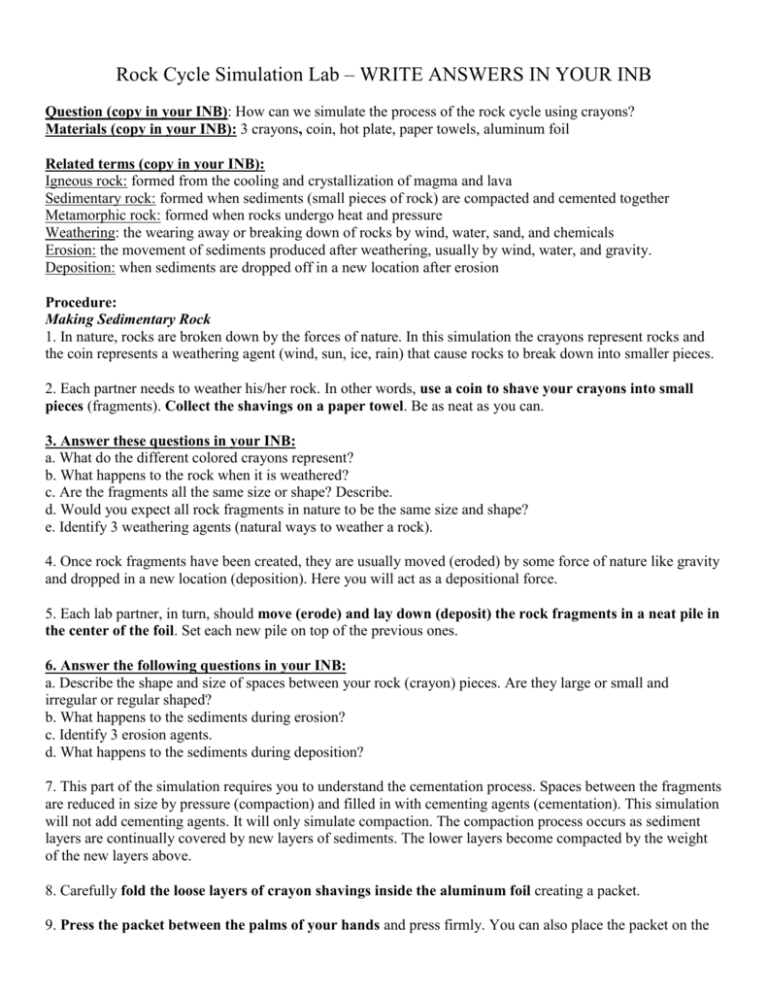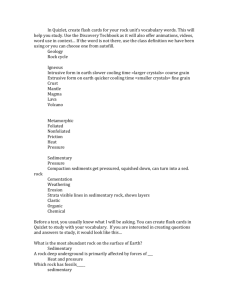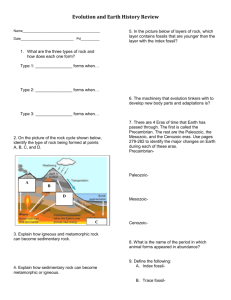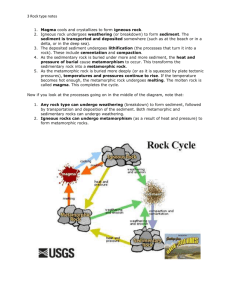Rock Cycle Simulation Lab
advertisement

Rock Cycle Simulation Lab – WRITE ANSWERS IN YOUR INB Question (copy in your INB): How can we simulate the process of the rock cycle using crayons? Materials (copy in your INB): 3 crayons, coin, hot plate, paper towels, aluminum foil Related terms (copy in your INB): Igneous rock: formed from the cooling and crystallization of magma and lava Sedimentary rock: formed when sediments (small pieces of rock) are compacted and cemented together Metamorphic rock: formed when rocks undergo heat and pressure Weathering: the wearing away or breaking down of rocks by wind, water, sand, and chemicals Erosion: the movement of sediments produced after weathering, usually by wind, water, and gravity. Deposition: when sediments are dropped off in a new location after erosion Procedure: Making Sedimentary Rock 1. In nature, rocks are broken down by the forces of nature. In this simulation the crayons represent rocks and the coin represents a weathering agent (wind, sun, ice, rain) that cause rocks to break down into smaller pieces. 2. Each partner needs to weather his/her rock. In other words, use a coin to shave your crayons into small pieces (fragments). Collect the shavings on a paper towel. Be as neat as you can. 3. Answer these questions in your INB: a. What do the different colored crayons represent? b. What happens to the rock when it is weathered? c. Are the fragments all the same size or shape? Describe. d. Would you expect all rock fragments in nature to be the same size and shape? e. Identify 3 weathering agents (natural ways to weather a rock). 4. Once rock fragments have been created, they are usually moved (eroded) by some force of nature like gravity and dropped in a new location (deposition). Here you will act as a depositional force. 5. Each lab partner, in turn, should move (erode) and lay down (deposit) the rock fragments in a neat pile in the center of the foil. Set each new pile on top of the previous ones. 6. Answer the following questions in your INB: a. Describe the shape and size of spaces between your rock (crayon) pieces. Are they large or small and irregular or regular shaped? b. What happens to the sediments during erosion? c. Identify 3 erosion agents. d. What happens to the sediments during deposition? 7. This part of the simulation requires you to understand the cementation process. Spaces between the fragments are reduced in size by pressure (compaction) and filled in with cementing agents (cementation). This simulation will not add cementing agents. It will only simulate compaction. The compaction process occurs as sediment layers are continually covered by new layers of sediments. The lower layers become compacted by the weight of the new layers above. 8. Carefully fold the loose layers of crayon shavings inside the aluminum foil creating a packet. 9. Press the packet between the palms of your hands and press firmly. You can also place the packet on the table, put your palms of your hands on the top of the packet, and press down. This will compact your weathered and eroded rocks (crayon shavings). 10. Answer the following questions in your INB: a. Describe the compaction. Are the sediments tightly or loosely compacted? b. Do you see any layers? Are they thin or thick? c. Which type of rock is formed after all of these processes (weathering, erosion, deposition, compaction and cementation) have occurred? 11. Save one small piece of the “sedimentary rock.” Making a Metamorphic Rock 12. As the rocks are pushed deeper into the Earth’s crust, pressure and temperature increases. Metamorphic rock may become contorted (twisted) in appearance and actually flow like a plastic material in response to the heat and pressure that is caused by the overlying rocks. 13. Rewrap the loosely compacted, sedimentary rock-type crayons shavings in the aluminum foil. 14. Bring your folded packet to the front of the classroom to apply heat and pressure to your sedimentary rock. 15. Answer the following questions in your INB: a. Do you see any layers? Describe any layers that you see. b. What type of rock is formed by heat and pressure? c. In nature, what is causing the increase in temperature and pressure? 16. Save one small piece of the “metamorphic rock.” Making Igneous Rock 17. Igneous rocks form deep within the earth. They originate in magma chambers embedded in solid rock. 18. Take your remaining crayon rock in the aluminum foil to the front of the classroom to be melted. The cooling process will then form igneous rock. 19. Answer the following questions in your INB: a. Describe what the melted “rock” (magma) looked like. b. Describe the cooling process and the final appearance of the “igneous” rock. c. Would your igneous rock be considered an intrusive or extrusive rock? Explain. 20. Save one small piece of the “igneous rock.” Conclusions – answer the following questions in your INB: Look at all three “rock” samples. Use your simulated “rocks” to help you describe the following rock types. 1. What is a sedimentary rock? 2. What processes must occur to produce a sedimentary rock? 3. What is a metamorphic rock? 4. What processes must occur to produce a metamorphic rock? 5. What is an igneous rock? 6. What processes must occur to produce an igneous rock? 7. What is the difference between an extrusive and intrusive igneous rock? 8. Is there evidence of the original rocks (the 3 crayons) in the igneous, metamorphic, and sedimentary rocks that you made? Explain. ROCK CYCLE SIMULATION LAB QUESTIONS (ANSWER IN YOUR INB) 3. Answer these questions in your INB: a. What do the different colored crayons represent? b. What happens to the rock when it is weathered? c. Are the fragments all the same size or shape? Describe. d. Would you expect all rock fragments in nature to be the same size and shape? e. Identify 3 weathering agents (natural ways to weather a rock). 6. Answer the following questions in your INB: a. Describe the shape and size of spaces between your rock (crayon) pieces. Are they large or small and irregular or regular shaped? b. What happens to the sediments during erosion? c. Identify 3 erosion agents. d. What happens to the sediments during deposition? 10. Answer the following questions in your INB: a. Describe the compaction. Are the sediments tightly or loosely compacted? b. Do you see any layers? Are they thin or thick? c. Which type of rock is formed after all of these processes (weathering, erosion, deposition, compaction and cementation) have occurred? 15. Answer the following questions in your INB: a. Do you see any layers? Describe any layers that you see. b. What type of rock is formed by heat and pressure? c. In nature, what is causing the increase in temperature and pressure? 19. Answer the following questions in your INB: a. Describe what the melted “rock” (magma) looked like. b. Describe the cooling process and the final appearance of the “igneous” rock. c. Would your igneous rock be considered an intrusive or extrusive rock? Explain. Conclusions – answer the following questions in your INB: Look at all three “rock” samples. Use your simulated “rocks” to help you describe the following rock types. 1. What is a sedimentary rock? 2. What processes must occur to produce a sedimentary rock? 3. What is a metamorphic rock? 4. What processes must occur to produce a metamorphic rock? 5. What is an igneous rock? 6. What processes must occur to produce an igneous rock? 7. What is the difference between an extrusive and intrusive igneous rock? 8. Is there evidence of the original rocks (the 3 crayons) in the igneous, metamorphic, and sedimentary rocks that you made? Explain.







